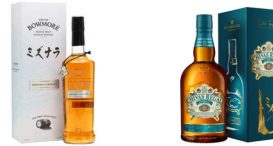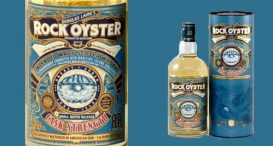The whisky making process – Bourbon vs. Scotch
Check out this great infographic from American Bartenders School!

Whiskey Making Process (Simplified)
Whiskey is a spirit that is distilled from fermented grain mash. This same grain mash is the stuff that is also used to make beer. In both processes, the grain is steeped in hot water for a time to release sugars. This sugary liquid becomes “wort”. Then the wort is fermented, by adding yeast, which converts the sugar to alcohol.
The only difference is that when making beer, they also add hops when producing the wort. This helps add flavor to the beer and balances the sweetness. Whiskey doesn’t need hops because it ages in oak barrels to balance the flavors.
So, after the wort is fermented, it becomes ‘wash’. This is fermented liquid that is ready to get distilled. From here it is placed in a still, such as a pot still or column still. This heats up the liquid and the vapors travel through a pipe at the top and come out the other side. During this distilling process, the alcoholic content is increased. This happens two or three times and in some special cases up to twenty times – each time the liquid becomes more alcoholic. Then the whiskey is transferred into casks or barrels where it is aged. As they age, they are blended with other whiskies to create that particular brand’s signature flavor.
This is the process in the most simple form.
The type of whiskey produced, however, is dependent on many factors. These include the geography of the distillery, the type of grain used, the distillation method, the type of casks, and any other things added to the final product like coloring or other spirits.
Whiskey vs Whisky
This is highly debated, but comes down to the origins of the word and who you are talking to. The New York Times dove into this issue and came out with the understanding that if you are talking about whiskey in general, it is fine to say whiskEy. However, Canadian and Scottish folk say Whisky. So – when referring to scotch (because it’s from Scotland), you would say scotch whisky – no E.
Single Malt vs Blend
This is what you will hear most people talking about when they talk about whiskey. Basically, a SINGLE MALT whiskey is one that is created from one distillery, made from a mash that only uses one particular malted grain. (For example, a single malt scotch whisky is made from malted barley.)
A BLENDED whiskey is one that is the made from the blending of different types of whiskeys from many different distilleries.
You can also have BLENDED MALT, which is a blend of SINGLE MALT whiskeys.
IMPORTANT: All whiskies are blended! A single malt is still blended! So, don’t be a whiskey snob -only you can decide for yourself which whiskey is the ‘best’.
Kinds of Whiskey
Here is where things get a bit confusing. The easiest way to remember all of this is that it is ALL whiskey. The word that comes before it tells you where the whiskey comes from – and each country that makes whiskey has its own rules and laws that they have to abide by.
Scotch Whisky is whiskey that MUST be made in Scotland.
To be specific, it has to be
- Distilled twice
- Matured for a minimum of 3 years in oak casks
- Scotch whisky without an age statement may, by law, be as young as three years old
- Any age statement on the bottle, in the form of a number, must reflect the age of the youngest Scotch whisky used to produce that product.
- Scotch malt whiskies are divided into 4 main regions: Highland, Lowland, Islay, Speyside. (You can actually break it up into 7 regions, and include the regions called ‘Islands’, “Grain’, and ‘Campbeltown’.) Every region has certain distilleries that create scotch with flavors and aromas distinct to that region.
American Whiskey is whiskey made in America. However, unlike Scotch, some of these whiskeys below can be made outside of the US (with the exception of ‘Tennessee Whiskey’). There are several different kinds:
- Bourbon whiskey—made from mash that consists of at least 51% corn (maize)
- Corn whiskey(MOONSHINE)—made from mash that consists of at least 80% corn
- Malt whiskey—made from mash that consists of at least 51% malted barley
- Rye whiskey—made from mash that consists of at least 51% rye
- Rye malt whiskey—made from mash that consists of at least 51% malted rye
- Wheat whiskey—made from mash that consists of at least 51% wheat
All above must follow the following rules. They must be distilled to no more than 80% alcohol by volume, & barrelled at no more than 125 proof. (To clarify this even further – ‘Proof’ in the US is two times percentage of alcohol by volume. So, in order to be American Whiskey, it must be barreled at no less than 62.5% alcohol by volume.)
- Only water may be added to the final product -the addition of colouring or flavouring is prohibited.
- Must be aged in NEW charred-oak containers, (except for corn whiskey which does not have to be aged Corn whiskey is usually un-aged and sold as a legal version of moonshine. This is also why moonshine isn’t a dark color like other whiskeys – because the barrel aging process is where most of the color comes from.)
The reason these are in place is because back in the 1800’s, old timer distillers used to mess with their whiskeys, sometimes trying to enhance the flavor, other times trying to dilute them. This eventually led to the Bottle in Bond Act of 1897, which helped come up with the stipulations above.
Tennessee whiskey is American whiskey that is made using the ‘Lincoln County Process’. Before the whiskey is moved to the barrels or casks, it is filtered or steeped in charcoal. This was signed into law by the governor of Tennessee on May 13, 2013. The most popular of these is Jack Daniel’s.
Canadian Whiskey is whiskey made in Canada. Here the rules are a bit different.
- May contain caramel and flavouring in addition to the distilled mash spirits,
- No maximum limit on the alcohol level of the distillation.
- To be exported under one of the “Canadian Whisky” designations, a whisky cannot contain more than 9.09% imported spirits.
Irish Whiskey is whiskey that MUST be produced in Ireland – Irish whiskeys are normally distilled three times (with one exception).
By law, Irish whiskey must be:
-produced in Ireland
-aged in wooden casks for a period of no less than three years
-unpeated malt is almost always used
Japanese Whisky has been growing in popularity since the early 2000s. They produce whiskey that is most similar to single malt scotch from Scotland. It is also made from malted barley. Popular brands include Nikka and Suntory. Japanese whisky is also closer in taste to traditional Scotch whisky because many of the Japanese companies are buying distilleries in Scotland in order to make their whiskies.
So remember, whiskey is a category. We advise you to try all the different kinds. Get to know your favorite brands and tastes. Visit a distillery! The more informed that you can be, the better you will be as a bartender. And the better you are as a bartender, the more cash you will make!













3 thoughts on “The whisky making process – Bourbon vs. Scotch”